Table of Contents
Embarking on a Creative Voyage: Interior Design and Decoration After 12th
The Gateway to Interior Designing After 12th
Interior Designing Eligibility and Entry Criteria
Diverse Courses to Shape Your Future
Table 1: Course Comparison for Aspiring Interior Designers
Course Fees: Investing in Your Future
Table 2: Financial Planning - Course Fees and Scholarship Options
The Boundless Scope in Interior Designing
Crafting a Career in Interior Design
Navigating the Academic Path: Choosing the Right Institution
Financial Planning and Scholarships
The Digital Edge: Embracing Technology in Interior Design
Internships and Real-World Experience
Building a Portfolio: Your Creative Signature
Looking Ahead: The Future of Interior Design
Conclusion
FAQ: Interior Design and Decoration Courses After 12th
The Gateway to Interior Designing After 12th
Can we do an interior designing course after 12th? Yes, and how! The journey into interior designing after 12th is accessible to students from all streams, be it arts, commerce, or science. This inclusivity ensures that passion for design and creativity is the primary criterion, making it a versatile career choice.
Interior Designing Eligibility and Entry Criteria
To embark on this path, interior designing eligibility requires completion of the 12th grade from a recognized education board. Students pondering how to become an interior designer after 12th will find that while an interior design course after 12th art may offer a direct correlation due to its creative curriculum, an interior design course after 12th commerce or science is equally valid, showcasing the field's diverse entry points.
Diverse Courses to Shape Your Future
- BA Interior Design Course: This undergraduate program is designed to provide a deep dive into the principles of interior design, space planning, and the integration of aesthetic concepts with functional requirements.
- Diploma in Interior Design: A shorter, more focused alternative for those eager to kickstart their career, offering practical skills and industry insights in a condensed time frame.
- MA in Interior Design: For individuals looking to advance their knowledge or specialize in a particular aspect of interior design, pursuing an MA in interior design post-graduation is an excellent choice.
Table 1: Course Comparison for Aspiring Interior Designers
|
Course Type |
Duration |
Focus |
Ideal For |
|
BA Interior Design |
4 years |
Comprehensive understanding of design principles, space planning, and aesthetics. |
Students looking for a thorough academic and practical education in interior design. |
|
Diploma in Interior Design |
1-2 years |
Focused practical skills and industry insights for early career start. |
Individuals seeking a quick entry into the interior design industry. |
|
MA in Interior Design |
2 years |
Advanced concepts, research methodologies, and specialization in interior design. |
Graduates aiming for higher specialization or academic research in interior design. |
This table offers a succinct overview of the different educational pathways available to students after the 12th, highlighting the duration, focus, and ideal candidates for each course type.
With specific criteria for interior design after 12th art that might include portfolio reviews, students from commerce backgrounds should also note the interior design course after 12th commerce prerequisites, ensuring all aspirants are well-informed.
Course Fees: Investing in Your Future
When it comes to interior designing course fees, the investment varies widely depending on the institution, course type, and duration. Prospective students should anticipate fees ranging from a few lakhs to several lakhs per annum, emphasizing the importance of financial planning and scholarship exploration.
Table 2: Financial Planning - Course Fees and Scholarship Options
|
Aspect |
Details |
|
Course Fees Range |
INR 1 lakh to INR 5 lakhs per annum, varying based on institution and course type. |
|
Scholarship Availability |
Merit-based, need-based, and institution-specific scholarships available. |
|
Part-Time Job Opportunities |
Opportunities for part-time jobs or internships during course to manage expenses. |
The Boundless Scope in Interior Designing
The scope in interior designing extends far beyond residential projects, encompassing commercial spaces, hospitality, event styling, and more, offering a dynamic career landscape. The industry's growth trajectory indicates a robust scope in interior designing, promising a bright future for dedicated professionals.
Crafting a Career in Interior Design
A career in interior designing after 12th is marked by creativity, innovation, and client satisfaction. Whether aspiring for a BA interior design course or looking ahead towards an MA in interior design, each educational step propels you closer to realizing your dream of transforming spaces.
Navigating the Academic Path: Choosing the Right Institution
Selecting the right institution for an interior design course after 12th is as crucial as choosing the course itself. The quality of education, faculty expertise, infrastructure, and industry connections play pivotal roles in shaping your future as an interior designer. Students should seek out colleges and universities that not only offer comprehensive interior designing course fees information upfront but also provide robust support in terms of internships, workshops, and placement opportunities. Researching alumni success stories can also offer valuable insights into the potential career trajectories post-graduation.
Financial Planning and Scholarships
Understanding interior designing course fees is integral to your academic journey. Given the variability in fees across different institutions, financial planning cannot be overstated. Prospective students should explore scholarship opportunities, financial aid, and part-time job options to manage interior designing course fees effectively. Institutions often offer financial assistance based on merit or need, which can significantly alleviate the financial burden and make your dream of pursuing a career in interior designing after 12th a reality.
The Digital Edge: Embracing Technology in Interior Design
In today's fast-paced world, interior design transcends traditional boundaries, integrating technology to create innovative spaces. From digital renderings to virtual reality (VR) walkthroughs, technology is reshaping the landscape of interior design. Aspiring designers should look for courses that incorporate modern tools and software, ensuring they stay ahead in the competitive industry. This technological fluency not only enhances the design process but also broadens the scope in interior designing, opening new avenues for creativity and innovation.
Internships and Real-World Experience
One of the key steps in how to become an interior designer after 12th is gaining practical experience through internships. Internships provide a real-world platform to apply theoretical knowledge, hone design skills, and understand client requirements. They also offer a glimpse into the workings of the industry, helping students build a professional network and enhance their resumes. When considering an interior design course after 12th, evaluate the internship opportunities and industry partnerships offered by the institution.
Building a Portfolio: Your Creative Signature
A compelling portfolio is your passport to the world of interior design. It reflects your creativity, skills, and understanding of design principles, serving as a powerful tool during job applications or freelance pitches. Starting from the projects you undertake during your BA interior design course or diploma, every piece of work contributes to your portfolio. Students should focus on diversity, showcasing a range of projects that highlight their versatility, innovative thinking, and problem-solving abilities.
Looking Ahead: The Future of Interior Design
The future of interior design is bright, with advancements in sustainable practices, smart homes technology, and user-centric designs shaping the industry. As environmental awareness grows, the demand for eco-friendly and energy-efficient designs is on the rise, expanding the scope in interior designing. Furthermore, the integration of smart technology in homes and commercial spaces is creating new challenges and opportunities for interior designers.
Conclusion
Embarking on an interior design course after 12th opens up a world where creativity meets functionality. Whether it’s through a BA interior design course, a diploma, or even an MA in interior design, the journey is filled with opportunities for growth, innovation, and making a tangible impact on people's lives. By carefully considering the course structure, fees, technological integration, and practical experience offered by institutions, students can make informed decisions about their education and career paths. The field of interior design is ever-evolving, and for those with a passion for creating beautiful, functional spaces, it offers a fulfilling career path with limitless possibilities.
FAQ: Interior Design and Decoration Courses After 12th
Q1: Can I pursue an interior design course after 12th regardless of my stream?
A1: Yes, students from any stream (arts, commerce, or science) can pursue an interior design course after 12th. The field values creativity and passion over specific academic backgrounds.
Q2: What is the eligibility for enrolling in an interior design course?
A2: The basic eligibility for interior designing courses is the completion of 12th grade from a recognized board. Some institutions may have additional criteria, such as an entrance exam or a portfolio review, especially for BA Interior Design courses.
Q3: How long does it take to complete an interior design course?
A3: The duration varies by the type of course: a BA Interior Design course typically lasts 4 years, Diploma courses can range from 1-2 years, and an MA in Interior Design is generally a 2-year program.
Q4: What are the fees for interior designing courses?
A4: Interior designing course fees can range from INR 1 lakh to INR 5 lakhs per annum, depending on the institution and the type of course (diploma, bachelor's, or master's).
Q5: Are there any scholarship opportunities available for interior design courses?
A5: Yes, many institutions offer merit-based, need-based, and institution-specific scholarships for interior design courses. It's advisable to contact the admissions office of the respective institutions for detailed information.



